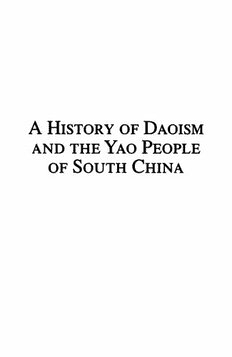
A History of Daoism and the Yao People of South China PDF
Preview A History of Daoism and the Yao People of South China
A H D istory of aoism Y P and the ao eople S C of outh hina A H D istory of aoism Y P and the ao eople S C of outh hina Eli Alberts CAMBRIA PRESS Youngstown, New York Copyright 2006 Eli Alberts All rights reserved Printed in the United States of America No part of this publication may be reproduced, stored in or introduced into a retrieval system, or transmitted, in any form, or by any means (electronic, mechanical, photocopying, recording, or otherwise), without the prior permission of the publisher. Requests for permission should be directed to [email protected], or mailed to Permissions, Cambria Press, PO Box 350, Youngstown, New York 14174-0350. Front cover photo courtesy of Eugene Goh, Singapore. Library of Congress Cataloging-in-Publication Data Alberts, Eli. A History of Daoism and the Yao people of South China / Eli Alberts. p.cm. Includes bibliographical references and index ISBN-13:978-1-934043-14-1 (alk. paper) 1. Yao (Southeast Asian people)—China 2. Taoism. I. Title. DS731.Y3A53 2006 304.8*95978—dc22 2006034618 For my parents Table of Contents Foreword....................................................................................................xiii Acknowledgments..................................................................................xix Introduction....................................................................................................1 The Discovery of Yao Daoism.....................................................1 The Dao among the Yao Revisited.............................................2 Yao Daoism Before Liberation...................................................5 The Context of Strickmann’s Argument...............................12 Daoism and Sinification...............................................................14 The Significance and Plan of the Present Work.................17 Part I: Yao....................................................................................................21 Chapter One : Genealogy of a Label: Center and Periphery.....................23 Introduction......................................................................................23 The Jade Radical and Allusions to Immortal Realms.... 25 viii Table of Contents The Dog Radical and Associations with Wild Beasts.........26 Radical Questions: What was the Earliest Form?............28 The Moyao M3S» OS...............................30 Connecting Moyao with Yaoren...............................................35 Yaoren as the Opposite of Moyao...........................................39 Conclusion........................................................................................46 Chapter Two : Yao People and The Southern Man Narrative...49 The Narrative Elements..............................................................49 Jingzhou and the Jingman ....................................51 Generic and Specific Applications of the Term Man.....52 Panhu and the Wuling Man........................................................54 The Peach Blossom Spring and the Five Streams............55 Strange and Impenetrable Topography.................................58 Grotto Worlds...................................................................................61 Peach Blossom Spring Grotto and Meishan Mountain.......63 The Man as Outsiders wairen £bÂ.......................................65 Table of Contents ix The Panhu Myth as the Basis of Man and State Claims..................................................................67 Taxation and Corvée.....................................................................70 Conclusion........................................................................................73 Chapter Thr ee: The Man Inhabitants of Ba and the Li Family......................75 The Linjun Myth and the Ba Clan..........................................76 The Banshun Man..........................................................................80 Cong People.....................................................................................83 The Li Family.................................................................................84 The Banshun Man and the Pacification of the Qiang Tribes...........................................................................89 The Li Family and the Celestial Masters.............................91 The surname Li and Dao-ification I Sinification............91 Conclusion........................................................................................93 Part II: Dao..................................................................................................95 Chapter Fou r: The Emergence and Spread of the Celestial Masters....................97 Definitional Domains of the Term “Daoism”....................98 X Table of Contents The Early Celestial Masters and Chinese Officialdom..........................................................................101 The Western Han Conception of the Sagely Ruler.................................................................104 The Utopian Vision of the Taipingjing................................107 The Taipingjing as a Daoist or Proto-Daoist Text.........112 The Yellow Turbans and the De-Centralization of Imperial Authority......................................................113 Banshun Man Connections to the Yellow Turbans.......116 Daoism and Becoming Chinese.............................................118 How Yao Became Daoists: Strickmann’s Argument..................................................121 Conclusion......................................................................................126 Chapter Five: Textual Mandate on the Periphery: Script, Image, and Legitimacy in Yao Culture.................................129 The Passport for Crossing the Mountains..........................132 The Myth of Crossing the Sea................................................134 Visual Framing of the Text.......................................................136
